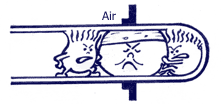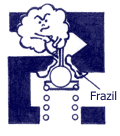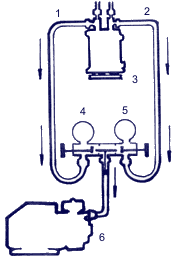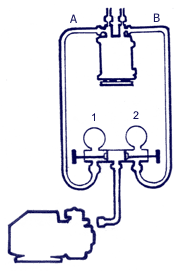

| NEWS | |||||||
| ABOUT | |||||||
| PRODUCTS AND SERVICES | |||||||
|
| |||||||
| PLACE AN ORDER | |||||||
| DOWNLOAD | |||||||
| HELPFUL HINTS | |||||||
| FAQ | |||||||
| LINKS | |||||||
| SEARCH | |||||||
| SITE MAP | |||||||
| CONTACT | |||||||
| русский |
How to fill the conditioner with the refrigerant
In this chapter there is given the material concerning refuelling of the system of conditioning by the refrigerant beginning with preliminary checks and finishing with distinctive features under the information of the conditioners using "new" refrigerant R-134a. Attention: Before beginning of realization of the works connected to system of conditioning, it is necessary to familiarize with the safety precautions described in the first chapter of the second part of this book.
|
|
 Air exhaust
Air exhaust
The scheme of connection of devices.
Wrench capsules of target and entrance valves of the compressor.
Attach the vacuum pump to the union located in the centre of a manometer.
After opening the valves low and high pressure of a manometer, start the vacuum pump.
*Operation on air exhaust is carried out for 5-10 minutes up to achievement of vacuum on a manometer of low pressure of 711,2-736,2 mm. This value is a degree of underpressure which is impossible to receive at a level of 0 m from a sea level, and depending on change of height through 304 m, the degree of underpressure decreases by 25,4 mm.
Example: at height of 1524 m it is possible to perform work before achievement of tenuity 584,2-609,6 mm.
If it is not possible to receive the specified value of tenuity, then after closing the adjusting vacuum valve and a stop of the vacuum pump it is necessary to check up whether there is no outflow in places of connections or in the pump.
|
If the manometer shows regulated value of underpressure, the system becomes completely rarefied. Therefore, after having closed valves of high and low pressure of a manometer, they stop work of the vacuum pump and disconnect an average hose.
Attention: It is necessary to disconnect the hose after a full stop of the vacuum pump. If at first to disconnect a hose in system, foreign substances may get in.
Having waited approximately 10 minutes, they check if the indication of a manometer varies. If it doesn’t, start to work on filling the refrigerant.
If within 10 minutes the indication of underpressure varies, then after having filled into the system 420 ml of the refrigerant, they check and define places of outflow. Again after having let out the refrigerant, after elimination of places of outflow, again they carry out work on air exhaust.
 Air and moisture completely need to be pumped out from the refrigerating system because if in the system of conditioning they will stay there may be bad consequences:
Air and moisture completely need to be pumped out from the refrigerating system because if in the system of conditioning they will stay there may be bad consequences: Moisture at transformation into the refrigerant of low pressure freezes in apertures of expansion valve and causes its corking.
Moisture at transformation into the refrigerant of low pressure freezes in apertures of expansion valve and causes its corking.
